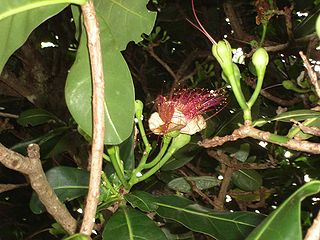
The Lecythidaceae comprise a family of about 20 genera and 250–300 species of woody plants native to tropical South America, Africa, Asia and Australia.

Polypodiaceae is a family of ferns. In the Pteridophyte Phylogeny Group classification of 2016, the family includes around 65 genera and an estimated 1,650 species and is placed in the order Polypodiales, suborder Polypodiineae. A broader circumscription has also been used, in which the family includes other families kept separate in PPG I. Nearly all species are epiphytes, but some are terrestrial.

Cyphomandra was a genus in the flowering plant family Solanaceae. It used to contain about 35 species native to the Americas from Mexico southwards to Northern Argentina.

Menispermaceae is a family of flowering plants. The alkaloid tubocurarine, a neuromuscular blocker and the active ingredient in the 'tube curare' form of the dart poison curare, is derived from the South American liana Chondrodendron tomentosum. Several other South American genera belonging to the family have been used to prepare the 'pot' and calabash' forms of curare. The family contains 68 genera with some 440 species, which are distributed throughout low-lying tropical areas with some species present in temperate and arid regions.

Woodwardia is a genus of ferns in the family Blechnaceae, in the suborder Aspleniineae of the order Polypodiales. Species are known as chain ferns. The genus is native to warm temperate and subtropical regions of the Northern Hemisphere. They are large ferns, with fronds growing to 50–300 cm long depending on the species.

Amphitecna is a genus of plants in the family Bignoniaceae.

Olax is a plant genus in the family Olacaceae. The name derives from the Latin, olax (malodorous), and refers to the unpleasant scent of some of the Olax species.

Thismia is a genus of myco-heterotrophic plants in family Burmanniaceae, first described as a genus in 1845. It is native to East and Southeast Asia, New Guinea, Australia, New Zealand, and the Americas.

Salacia is a genus of plants in the family Celastraceae. They are woody climbers naturally found in tropical regions.

Trevoa is a genus of actinorhizal plants; these dicotyledon flora are trees or small shrubs. The genus was first proposed by Miers in 1825, but was not fully described until 1830 by Sir William Jackson Hooker. Genus members are notable for their ability to fix nitrogen. Species of this genus are generally found in the near coastal forests and arid shrubland of South America. Some species are localized in the mountains of central Chile; for example, the species Trevoa trinervis occurs in the La Campana National Park and other proximate areas of central Chile.

Kippistia is a genus of flowering plants in the daisy family. The name commemorates Richard Kippist, librarian to the Linnean Society.

Psychotrieae is a tribe of flowering plants in the family Rubiaceae and contains about 2114 species in 17 genera. Its representatives are found in the tropics and subtropics.

Rhigospira is a genus of flowering plants in the family Apocynaceae, first described as a genus in 1878 by John Miers. The species, Rhigospira quadrangularis was first described as Ambelania quadrangularis by Johannes Müller Argoviensis in 1860 but was transferred to the genus, Rhigospira, in 1878 by John Miers. The genus contains only one known species, Rhigospira quadrangularis, native to northwestern South America.
Allantoma is a genus of woody plant in the family Lecythidaceae first described as a genus in 1874. It is native to northwestern South America (Colombia, Venezuela, Peru, northern Brazil.
- Allantoma decandra S.A.Mori, Ya Y.Huang & Prance - Peru, Brazil
- Allantoma integrifolia S.A.Mori - Amazonas State in Brazil
- Allantoma kuhlmannii S.A.Mori - Rondônia State in Brazil
- Allantoma lineata Miers - Amazonas State in Venezuela; Amazonas and Pará States in Brazil
- Allantoma pachyantha S.A.Mori, Ya Y.Huang & Prance - Amazonas State in Brazil
- Allantoma pauciramosa S.A.Mori, Ya Y.Huang & Prance - Amazonas State in Brazil
- Allantoma plurifloraS.A.Mori, Ya Y.Huang & Prance - Colombia
- Allantoma uaupensis S.A.Mori, Ya Y.Huang & Prance - Amazonas State in Brazil

Witheringia is a genus of flowering plants in the family Solanaceae, with a neotropical distribution. It is closely related to Physalis.

Hippocratea is a genus of flowering plants in the family Celastraceae, usually lianas, native to tropical and subtropical North America, South America and Africa.
Antizoma is a genus of flowering plants belonging to the family Menispermaceae.
Aptandra is a genus of flowering plants belonging to the family Olacaceae.
Brachistus is a genus of flowering plants belonging to the family Solanaceae.
Cuervea is a genus of flowering plants belonging to the family Celastraceae.













